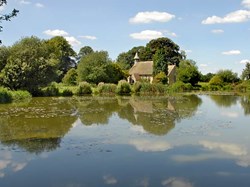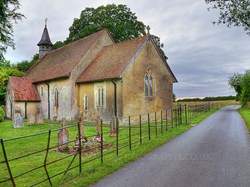Hartley Mauditt
Brief History
Hartley Mauditt was first documented in the Domesday Book as ‘Herlege’ meaning hartland or woodland. The Manor had been granted to William de Mauditt by William the Conqueror.
The best known part of Hartley Mauditt today is the peaceful area near the pond where the small 12th century church of St Leonards now stands alone by the pond; all that remains of a vanished settlment. Services continue to be held here despite the reduced number of parishioners. This area is a Scheduled Ancient Monument and a Listed Landscape.
In fact a site near the church was occupied by the manor house of the Stuart family from the early 1600s for nearly 200 years – together with all the buildings associated with running such an establishment. It is also said that the earthworks show ‘the former position of about 10 dwellings, croft boundaries and other enclosures’. In the 1665 Hearth Tax, the main house was assessed as having 15 hearths and there were 21 other dwellings in the parish – although some of them may have been on the sites of the present farms.
Thomas Gatehouse’s entry for Hartley Mauditt in his ‘Short Survey of the County of Southampton’ of 1778 reads ‘A Capital uniform mansion surrounded by the park and largely encompassed by its own demesnes, arable pasture and Woodlands. From a grand natural terrace on the south-east part of the park the country around exhibits a most beautiful and extensive prospect and is so formed by nature from its declivity and hanging woods that without the assistance of a Mr Brown it affords both pleasure and profit.’
The Stuarts had been living beyond their means for many years and their property was put up for sale in September 1779. A sale of the contents began on a Monday 26 April (probably 1784) and lasted seven days. The catalogue lists sumptuous fittings, including oak panelling and marble fireplaces now thought to be in homes in the area; personal possessions from pistols and snuff boxes to an ivory and gold diary and her ladyship’s dressing table; and the contents of stables for racehorses and the hot house for melons. The Round House, on the B3006, was a lodge to the big house and is the only remaining part of the complex.
The property was later acquired by Henry Lord Stawell. The peaceful area around the church and pond is a Scheduled Ancient Monument and Listed Landscape [Park and Garden] and historic maps show that there was once an avenue of trees.
There are few remaining houses and almost all are old. Jeffries Cottage is listed as a part timbered17th century cottage. The former rectory and old shool date from the mid19th century. At least two sites of the farms are mentioned in14th century documents, ‘Candevere’ and ‘Barlie Bridge’
Like other farms around, Hartley Park Farm grew hops and was the last farm in the area to do so having only recently changed to planting lavender and producing all kinds of items that can be made with the oils.



